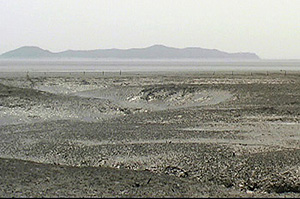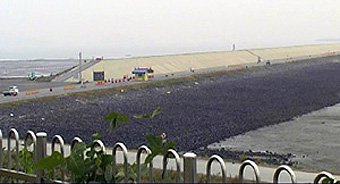
Saemangeum, a wetland linked inextricably with the future of species such as the Spoon-billed Sandpiper. It is not only birdwatchers who should be alarmed at the loss of such species and a global decline in biodiversity..
Birds are key indicators of the health of ecosystems: their disappearance signals the loss of conditions and the species which supported them. Loss of intertidal wetland has already reached critical levels in East Asia. What will happen to the Spoon-billed Sandpiper, and the other East Asian-Australasian Flyway species dependent on Korean tidal-flats, if the seagates at Saemangeum close...?
The Yellow Sea eco-region, comprising the coastal wetlands and marine areas of South Korea, DPRK and China, is listed in WWF's Global 200, and has been selected as one of the focal ecoregions in the Asia Pacific. Despite extensive reclamation projects, increasing pollution and unsustainable resource use, the Yellow Sea Ecoregion still contains more than 1 million ha of tidal-flats, supports a massive fisheries industry and maintains internationally important concentrations of a significant percentage of East Asia's migratory waterbirds (Moores et al. 2001). In many respects it can be considered the East Asian counterpart of North Europe's Wadden Sea. Within this eco-region, one of the most important known sites for biodiversity is located on the west coast of South Korea (centred at approximately 35 Deg 50'N, 126 Deg 45'E): Saemangeum. .
Comprising the two free-flowing estuaries of the Mangyeung and Dongjin rivers, the Saemangeum wetland (pronounced "Say-Man-Gum" in English) comprises some 30 000 ha of tidal-flats and 10 000 ha of shallows, and supports 27 (possibly as many as 30) species of waterbird in internationally important concentrations. No less than 7 of these are believed globally threatened (Asia-Pacific Migratory Waterbird Conservation Committee, 2001)..
Significant waterbird counts include up to 200 of the fast-declining and probably Endangered Spoon-billed Sandpiper Eurynorhynchus/Calidris pygmeus, the world's highest recent count of the Endangered Spotted/Nordmann's Greenshank Tringa guttifer, a peak of over 86,000 Great Knot Calidris tenuirostris (ca 30-40% of the total world population), and over 700 of the Vulnerable Saunders's Gull Larus saundersi. By 1998, at least 158 species of fish and 64 species of benthos had also been recorded in the area.

With such outstanding importance for biodiversity (being considered, for example, the most important known site for shorebirds in the whole Yellow Sea by the region's Shorebird Working Group, Mark Barter in lit; Barter 2002), it would be expected that the South Korean government, in fulfilling its obligations to both the Ramsar Convention (ratified in 1997) and the Convention on Biological Diversity (ratified in 1994), would ensure the area's conservation. This would mirror conservation initiatives in Europe, whereby the Wadden Sea became both a National park (shared by three countries) and a Ramsar site..
In stark contrast, however, the entire area of 40 100 ha (two-thirds the size of the Wash in the UK) is presently being reclaimed, in the world's largest known coastal wetland reclamation project.

First dreamt up in the 1970s, a more formal reclamation plan was endorsed by the then military government in the late 1980s, with the stated aims of (1) increasing national territory (despite the tidal-flats already being part of South Korea) and (2) of creating more land for rice culture, thus assisting in national food self-sufficiency. Although the latter can be considered a noble aim, a subsequent gradual shift in national diet away from rice, combined with advances in rice-growing technology, has led to a massive annual rice surplus in South Korea since 1996, which was estimated to reach 1.9 million tons by October 2002 (Korea Herald, July 27 2002). The surplus, twice that advised by the Food and Agriculture Organization, even threatens a rice price collapse, endangering farmers' livelihoods nationwide unless the government can act swiftly to reduce it. Meanwhile, the regional fisheries industry, supplying a multitude of "products" from tidal-flats and shallows, ranging from seaweeds through shellfish and crabs to fish, is already in significant decline, threatening the livelihoods of many fisherfolk and their community culture, a situation that will be severely worsened by the conversion of many harvested species' egg-laying and nursery areas into rice-field..

The first phase of the project (the construction of an outer seawall, wide enough to take two lanes of traffic and over 5m high) started in 1991, and despite increasing concerns is still ongoing in 2003, with almost all of the 33 km long wall already completed. As initially proposed the wall would dam off both estuaries in order to create 28 300 ha of rice-field and industrial land, and 11 800 ha of barrage lake. It appears that it could be completed in the near future, with the conversion of the tidal-flats to rice-fields following a few years later..

Construction costs of this outer wall alone had already exceeded 2.3 billion dollars by 2001, with the final costs many times higher still..
Progress of the project has not been smooth, with both significant financial and time overruns. Even at such a late date opposition, both popular and expert, continues to grow. The whole project was even temporarily suspended in 2000 to allow for some further research on possible environmental impacts by an expert panel, a move prompted by the failure of other similar, smaller reclaimed areas. These include the 17 000 ha Shihwa reclamation, already given up the government in 2000 as unusable for agriculture because of water pollution and other related technical problems..

The so-called Saemangeum expert review panel concluded after a year of intense review in 2001, contrary to government expectations, that this project too would inevitably produce significant environmental problems, including increased water pollution, declines in fisheries and impacts on other wildlife. The majority of the panel therefore called for the project's cancellation.
They were prevented several times from making public their findings.
After a series of delayed announcements, the government then dismissed all controversy and opposition and on May 25, 2001 the Saemangeum reclamation was restarted in "an environmentally friendly way" (government spokesperson, Korea Herald, May 26, 2001).

The "environmentally-friendly" reclamation's effect on the local hillsides.
Photo © Steve Couri.
By 2002 the government of South Korea still had not addressed the issue of loss of biodiversity, instead insisting (1) that it was too late to turn the project back, (2) that local people wanted the development and (3) that the only environmental issue remained maintenance of adequate water quality in the barrage lakes to allow for eventual irrigation of the rice-fields.
In line with other such projects, there would be no compensation for the project, beyond one-off payments to fishing communities for the loss of their fishing rights, and no significant modification of the design. Informed sources confidently identified regional politics and favoritism rather than national food self-sufficiency or smart economics as now being the main drive behind this project. The former president (Nobel Peace Prize winner President Kim Dae-Jung) hails from the province that neighbors Saemangeum, and was voted into power on the promise of providing massive funding for regionally popular developments, in order for the "under-developed" southwest Cholla provinces to catch up with the already well-funded rival Kyeongsan Provinces and the affluent Seoul/Gyeongii region.
His presidency came to an end in early 2003, and with this change, the possibility of cancellation again increased - only to be dashed again when the new President, Roh Moo Hyun, announced on June 5th that this disastrous project would continue - even though, it was admitted, there was now NO planned end-use for the polluted land that will be created...
The next phase of this story began on July 15th, when, remarkably a mid-level court in Seoul decided that as the water being created by the formation of the barrage lake would be so polluted that it could not be used for agriculture - thereby rendering the government's reason for continuing the reclamation illegitimate - the whole project must be suspended, effective immediately!

With this historic decision, protests have been stepped up considerably. The reclamation is opposed within Korea by the majority of Korean people (see Korean Protests for more details and images), by all the country's environmental groups, privately by the two main Ministries responsible for wetland conservation in South Korea (the Ministry of Environment and the Ministry of Maritime Affairs and Fisheries), and by a significant number of international NGOs outside of Korea, who recognize that the project will deal a significant blow to the ecological character of South Korea's west coast, leading to declines in the overall populations of several populations of migratory waterbirds.
Wetlands International, Birdlife International, the RSPB, and Friends of the Earth International have all sent letters of protest.
We at Birds Korea also continue to appeal to the broader international community to carry on educating their own governments and the media to help make the Saemangeum reclamation a major international issue. To aid this we have posted a "Saemangeum Reference Page" as a source of information for all interested parties: please pass the URL of this page on the Saemangeum mainpage.
For the sake of global biodiversity, we ask for your continuing support of the Korean Ministry of Environment, the Ministry of Maritime Affairs, and Korean NGOs and Korean people in requesting the Saemangeum project be cancelled once and for all.
With the help of the international birding community, maybe the Spoon-billed Sandpiper and the Nordmann's Greenshank will outlive the people reading this today.
References:
- Asia-Pacific Migratory Waterbird Conservation Committee (2001) Asia-Pacific Migratory Waterbird Conservation Strategy: 2001-2005. Wetlands International- Asia Pacific. Kuala Lumpur, Malaysia.
- Barter, M. (2002) Shorebirds in the Yellow Sea. Importance, Threats, and Conservation Status (AWSG).
- Moores, N. et al. (a 2001) Yellow Sea Ecoregion: Reconnaissance Report on Identification of Important Wetland and Marine Areas for Biodiversity. Volume 2: South Korea. Joint publication of WWF-Japan, Wetlands & Birds Korea, and Wetlands International China Program
- Moores, N. (b 2001) Internationally Significant Wetlands to be 100% Reclaimed. WWF Arctic Bulletin, No. 3.01, pp. 12-13.



